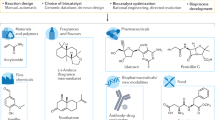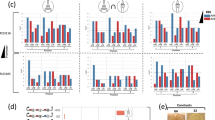Abstract
Developments in recombinant DNA technology are now allowing the controlled use of metabolic pathways to carry out a series of sequential organic chemical reactions using a single microbial catalyst. Biological processes of this type have significant industrial potential but in many cases still require the necessary biochemical engineering to translate them into a scalable process. Process synthesis is the systematic application of heuristics to the design of processes. Its application has enabled many chemical processes to be develped rapidly and feasibility assessed at an early stage in development Here we apply such techniques to the area of multi-step microbial conversions (the use of metabolic pathway engineering to produce industrially useful chemicals). Biological and process engineering issues which require more research are identified. The use of the aromatic oxidation pathway serves as an illustrative example
This is a preview of subscription content, access via your institution
Access options
Subscribe to this journal
Receive 12 print issues and online access
$209.00 per year
only $17.42 per issue
Buy this article
- Purchase on Springer Link
- Instant access to full article PDF
Prices may be subject to local taxes which are calculated during checkout
Similar content being viewed by others
References
Roberts, S.M. and Turner, N.J. 1992. Some recent developments in the use of enzyme catalysed reactions in organic synthesis. J. Biotech 22: 227–244.
Dordick, J.S. (Ed.). 1990. Biocatalysts for Industry. Plenum Press, New York.
Kieslich, K. 1991. Biotransformations of industrial use. Acta Biotechnol. 11: 559–570.
Lilly, M.D. 1992. Design and operation of biotransformation processes, p. 47–68. In: Recent Advances in Biotechnology. F. Vardar-Sukan and S. S. Sukan (Eds.). Kluwer Academic, Amsterdam.
Lilly, M.D. and Woodley, J.M. 1985. Biocatalytic reactions involving water-insoluble organic compounds, p. 179–192, In: Biocatalysts in Organic Syntheses. I. Tramper, H. C. van der Plas and P. Linko (Eds.). Elsevier, Amsterdam.
Klibanov, A.M. 1986. Enzymes that work in organic solvents. Chemtech 16: 354–359.
Woodley, J.M. and Lilly, M.D. 1992. Process engineering of two-liquid phase biocatalysis, p. 147–154. In: Biocatalysis in Non-Conventional Media. J. Tramper, H. H. Beeftink and TJ. von Stacker (Eds.). Elsevier, Amsterdam.
Woodley, J.M. and Lilly, M.D. 1994. Biotransformation reactor selection and operation, p. 371–393. In: Applied Biocatalysis. J. Cabral, D. Best, L. Boross and J. Tramper (Eds.). Harwood Academic, Chur.
Falch, E. 1991. Industrial enzymes—developments in production and application. Biotech. Adv. 9: 643–658.
Graycar, T.P. 1991. Protein engineering of subtilisin, p. 257–283. In: Biocatalysts for Industry. J. S. Dordick (Ed.). Plenum Press, New York.
Chen, K. and Arnold, F.H. 1991. Enzyme engineering for nonaqueous solvents: random mutagenesis to enhance activity of subtilisin E in polar organic media. Bio/Technology 9: 1073–1077.
Bailey, J.E. 1991. Toward a science of metabolic engineering. Science 252: 1668–1675.
Rudd, D.F., Powers, G.J. and Siirola, J.J. 1973. Process Synthesis. Prentice-Hall, New Jersey.
Gandikota, M.S., Davis, J.F., Yang, S.-T. and Marchio Jr., J. 1992. Bioprocess flowsheets made easy. Chemtech 22: 694–699.
Hack, C.J. 1992. Biochemical engineering studies of cis-glycol production. PhD Thesis, University of London, UK.
Woodley, J.M. and Lilly, M.D. 1990. Extractive biocatalysis: the use of two-liquid phase biocatalytic reactors to assist product recovery. Chem. Eng. Sci. 45: 2391–2396.
Gbewonyo, K., Buckland, B.C. and Lilly, M.D. 1991. Development of a large-scale continuous substrate feed process for the biotransformation of sim-vastatin by Nocardia sp. Biotechnol. Bioeng. 37: 1101–1107.
van den Tweel, W.J.J., Mersman, E.H., Vorage, M.J.A.W., Tramper, J. and de Bont, J.A.M. 1987. The application of organic solvents for the bio-conversion of benzene to cis-benzeneglycol, p. 231–241. In: Bioreactors and Biotransformations. G. W. Moody and P. B. Baker (Eds.). Elsevier, Amsterdam.
Regan, L., Bogle, I.D.L. and Dunnill, P. 1992. Simulation and optimization of metabolic pathways. Comp. Chem. Eng. 16: 237–247.
Regan, L., Bogle, I.D.L., Ward, J.M. and Dunnill, P. 1993. Initial control analysis of the TOL meta-cleavage pathway, p. 87–89. In: Proc. 1993 IChemE Research Event, IChemE, Rugby.
Holms, W.H., Hamilton, I.D. and Mousdale, D. 1990. Application of flux analysis to increase productivity of fermentation processes, p. 1057–1062. In: 5th European Congress on Biotechnology, Copenhagen, Proceedings Vol. 2. C. Christiansen, L. Munck, and J. Villadsen (Eds.). Munksgaard, Copenhagen.
Vallino, J.J. and Stephanopoulos, G. 1990. Intracellular flux analysis as means of identifying limiting nodes in amino acid fermentations, p. 1063–1066. In: 5th European Congress on Biotechnology, Copenhagen, Proceedings Vol. 2. Christiansen, L. Munck and J. Villadsen (Eds.). Munksgaard, Copenhagen.
Mattiasson, B. and Holst, O. 1991. Extractive Bioconversions. Marcel Dekker, New York.
Freeman, A., Woodley, J.M. and Lilly, M.D. 1993. In situ product removal as a tool for bioprocessing—an overview. Bio/Technology 11: 1007–1012.
Daugulis, A.J. 1988. Integrated reaction and product recovery in bioreactor systems. Biotechnol. Prog. 4: 113–122.
Yamada, K., Kinoshita, S., Tsunoda, T. and Aida, K. 1972 (Eds.). The microbial production of amino acids. Halsted Press, New York.
Mattiasson, B. and Larsson, M. 1985. Extractive bioconversions with emphasis on solvent production. Biotechnol. Gen. Eng. Rev. 3: 137–174.
Harrop, A.J., Woodley, J.M. and Lilly, M.D. 1992. Production of naphlhalene-cis-glycol by Pseudomonas putida in the presence of organic solvents. Enzyme Microb. Technol. 14: 725–730.
Kaasgaard, S., Karlsen, L., Schneider, I. 1992. Process for separation of two solid components. Patent WO 92/12782.
Yoshikawa, N., Mizuno, S., Ohta, K. and Suzuki, M. 1990. Microbial production of cis, cis-muconic acid. J. Biotechnol. 14: 203–210.
Box, G.E., Hunter, W.G. and Hunter, J.S. 1978. Statistics for Experimenters: An Introduction to Design, Data Analysis, and Model Building. Wiley, New York.
Barker, T.B. 1985. Quality By Experimental Design. Marcel Dekker Inc., New York.
Haaland, P.D. 1989. Experimental Design in Biotechnology. Marcel Dekker Inc., New York.
Lilly, M.D. and Dunnill, P. 1971. Biochemical Reactors. Process Biochem. 6: 29–32.
Lilly, M.D. and Dunnill, P. 1976. Immobilized-enzyme reactors, p. 717–738. In: Methods in Enzymology XLIV Immobilized Enzymes. K. Mosbach (Ed.). Academic Press, New York.
Woodley, J.M. 1992. Reactor engineering for multiphasic biotransformations, p. 146–149. In: Harnessing Biotechnology for the 21st Century. M. R. Ladisch and A. Bose (Eds.). Amer. Chem. Soc., Washington.
Lehrbach, P.R. and Timmis, K.N. 1983. Genetic analysis and manipulation of catabolic pathways in Pseudomonas. In: Biotechnology. C. F. Phelps and P. H. Clarke (Eds.). Biochem. Soc. Symp. 48: 191–219.
Chater, K.F. 1990. The improving prospects for yield increase by genetic engineering in antibiotic-producing streptomycetes. Bio/Technology 8: 115–121.
Skatrud, P.L. 1992. Genetic engineering of ß-lactam antibiotic biosynthetic pathways in filamentous fungi. TIBTECH 10: 324–329.
Sahm, H. 1990. Metabolic design in amino acid-producing bacteria, p. 956–966. In: 5th European Congress on Biotechnology, Copenhagen, Proceedings Vol. 1. C. Christiansen, L. Munck and J. Villadsen (Eds.). Munksgaard, Copenhagen.
Picataggio, S., Rohver, T., Deander, K., Lanning, D., Reynolds, R., Mielenz, J. and Eirich, L.D. 1992. Metabolic engineering of Candida tropicalis for the production of long-chain dicarboxylic acids. Bio/Technology 10: 894–898.
Backman, K., O'Connor, M.J., Maruya, A., Rudd, E., McKay, D., Balakrishnan, R., Radjai, M., DiPasquantonio, V., Shoda, D., Hatch, R. and Venkatasubramanian, K. 1990. Genetic engineering of metabolic pathways applied to the production of phenylalanine. Ann. N.Y. Acad. Sci. 589: 16–24.
Fell, D.A. 1992. Metabolic Control Analysis: a survey of its theoretical and experimental development. Biochem. J. 286: 313–330.
Robinson, G.K., Stephens, G.M., Dalton, H. and Geary, P.J. 1992. The production of catechols from benzene and toluene by Pseudomonas putida in glucose fed-batch culture. Biocatalysis 6: 81–100.
Maxwell, P., Voloch, M., Lynch, J. and Rozzell, J.D. 1990. Metabolic pathway engineering for the production of new chemicals, p. 255–258. In: 5th European Congress on Biotechnology, Copenhagen, Proceedings Vol. 1. C. Christiansen, L. Munck and J. Villadsen (Eds.). Munksgaard, Copenhagen.
Matcham, G.W., Giannousis, A., Adamus, J.E., Pegram, C. and Stirling, D.I. 1992. Production of pyridine dicarboxylic acids via meta cleavage pathways. SIM Annual Mtg, San Diego, CA.
Jenkins, R.O., Stephens, G.M. and Dalton, H. 1987. Production of toluene cis-glycol by Pseudomonas putida in glucose fed-batch culture. Biotechnol. Bioeng. 29: 873–883.
Reineke, W. 1986. Construction of bacterial strains with novel degradative capabilities for chloroaromatics. J. Basic Microbiol. 26: 551–567.
Ramos, J.L., Wasserfallen, A., Rose, K. and Timmis, K.N. 1987. Redesigning metabolic routes: manipulation of TOL plasmid pathway for catabolism of alkylbenzoates. Science 235: 593–596.
Mermod, N., Harayama, S. and Timmis, K.N. 1986. New route to bacterial production of indigo. Bio/Technology 4: 321–324.
Ensley, B.D., Ratzkin, B.J., Osslund, T.D., Simon, M.J., Wackett, L.P. and Gibson, D.T. 1983. Expression of naphthalene oxidation genes in Escherichia coli results in the biosynthesis of indigo. Science 222: 167–169.
Assinder, S.J. and Williams, P.A. 1990. The TOL plasmids: determinants of the catabolism of toluene and the xylenes. Adv. Microbiol Phys. 31: 1–69.
Williams, P.A. and Murray, K. 1974. Metabolism of benzoate and the methyl-benzoates by Pseudomonas putida (orvilla) mt-2: evidence for the existence of the TOL plasmid. J. Bacteriol. 120: 416–423.
Draths, K.M. and Frost, J.W. 1994. Environmentally compatible synthesis of adipic acid from D-glucose. J. Am. Chem. Sec. 116: 399–400.
Author information
Authors and Affiliations
Corresponding author
Rights and permissions
About this article
Cite this article
Marshall, C., Woodley, J. Process Synthesis for Multi-Step Microbial Conversions. Nat Biotechnol 13, 1072–1078 (1995). https://doi.org/10.1038/nbt1095-1072
Issue Date:
DOI: https://doi.org/10.1038/nbt1095-1072
This article is cited by
-
Multistep Conversion of para-Substituted Phenols by Phenol Hydroxylase and 2,3-Dihydroxybiphenyl 1,2-Dioxygenase
Applied Biochemistry and Biotechnology (2013)



